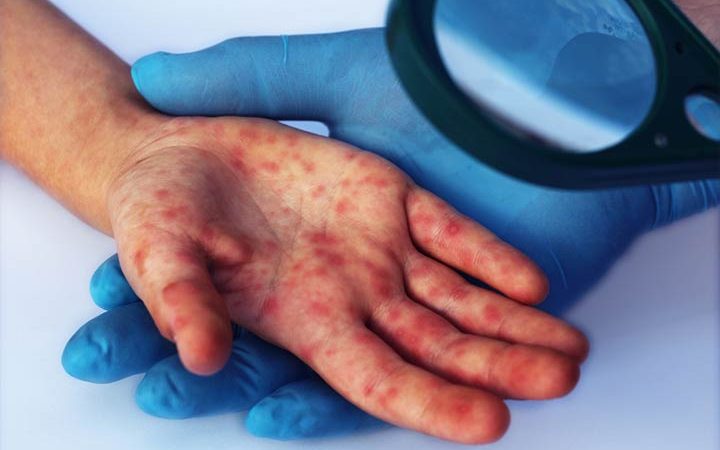Idiopathic thrombocytopenic purpura (ITP) is a blood disorder characterized by decreased platelet count. Platelets are a blood component that plays a major role in clotting. In ITP, due to this low platelet count, there is increased bleeding (1).
ITP is sometimes considered an autoimmune disease, where the immune system attacks external organisms as well as its platelets. Hence, this disorder is also called immune thrombocytopenia (2). Alternatively, it may occur after a viral infection, such as chickenpox, or be caused by reactions to medicines or vaccines (3).
Around four to eight children per 100,000 under 15 years are diagnosed with ITP in the US each year (4). This article discusses the causes, diagnosis, treatment, and prognosis of ITP in children.
Types Of ITP
Based on duration, ITP is of two types (2):
- Acute ITP: It usually occurs after a viral infection in children between one and seven years and lasts less than six months (1).
- Chronic ITP: It is common among adults but may also occur in children. It lasts for more than six months and affects adult females more than males (5).
Symptoms Of ITP In Children
Since the platelet count reduces in ITP, most symptoms are related to unregulated bleeding. These may include (6) (7).
- Petechiae (tiny red or purple spots under the skin)
- Easy bruising, which may or may not follow trauma
- Bleeding in the gums and nose
- Heavy menstruation (girls)
- Purpura (purple spots on the skin after blood has leaked under it)
- Blood in the vomit, urine, and stools
Diagnosis Of ITP In Children
ITP can be diagnosed in children with a physical exam and medical history analysis. Your medical provider may also suggest the following tests (3):
- Complete blood count (CBC): This test provides the count of each type of blood cell, including red blood cells (RBCs), white blood cells (WBCs), and platelets. The normal platelet count for a child is between 150,000 and 450,000. In a child with ITP, it may fall below 100,000 or, sometimes, below 10,000.
- Peripheral smear: This test observes a blood sample under a microscope to identify abnormal cells.
- Bone marrow aspiration: Bone marrow is the soft tissue in the center of the bones where blood cells are produced. A bone marrow aspiration requires the collection of a bone marrow sample, which is observed to analyze the production of platelets. This test is not commonly suggested.
Treatment For ITP In Children
Since most children experience acute ITP, which resolves within six months, treatment is not always necessary. However, based on the child’s disease severity, age, and general health, doctors may suggest a steroid or immunoglobulin treatment. These treatments either increase the platelet count or decrease its destruction (3) (8):
- Corticosteroids: Steroids can increase the platelet count within two to three weeks and are used as first-line therapy in the UK.
- Intravenous immune globulin (IVIg): It shows faster results than steroids by slowing down the destruction of platelets in the body.
- Anti-D or Rh immune globulin: It targets the spleen, the destruction site of platelets. However, as this treatment could reduce the RBCs, it is rarely suggested.
- Rituximab: This antibody increases platelet production by decreasing its destruction in the body.
- Splenectomy: This procedure involves the removal of the spleen and is only suggested in severe conditions.
Risks And Complications Of ITP In Children
The prognosis of ITP is good. However, sometimes, decreased platelets could cause internal bleeding. Furthermore, if not ITP itself, some treatment methods could cause complications. For example, corticosteroids could result in weight gain, osteoporosis (calcium loss in the bones), mood changes, and a slower growth rate (6) (9).
Similarly, the antibody rituximab could cause joint or muscle pains, decreased blood pressure, nausea, fever, chills, diarrhea, rashes, vomiting, decreased kidney or liver function, or low blood count (10).
Management Of ITP In Children
A pediatric patient with ITP can live a normal life. But they must take a few precautions considering how easily their bodies can bruise. Here are some management strategies (3) (4):
- Ensure your child wears protective gear while riding their bike or skateboarding. Also, confirm with a doctor if they can participate in contact sports such as football, rugby, and martial arts.
- Consider padding their beds.
- Do not give them aspirin, ibuprofen, or anti-inflammatory drugs as they may increase bleeding.
Call your doctor if you notice the following (5):
- Head injury and severe headache
- Dark stools and pee
- Severe bleeding or bruising
Acute ITP in children has a good prognosis and is rarely a life-threatening medical condition (2). However, children with ITP must be monitored closely upon diagnosis since they bleed easily. If the ITP doesn’t resolve on its own within a few months from diagnosis, it may be chronic, and your child may require further treatment accordingly.
References:
MomJunction’s articles are written after analyzing the research works of expert authors and institutions. Our references consist of resources established by authorities in their respective fields. You can learn more about the authenticity of the information we present in our editorial policy.
Recommended Articles
The following two tabs change content below.




































